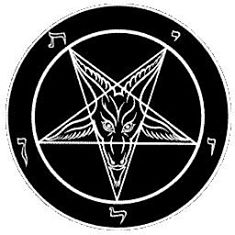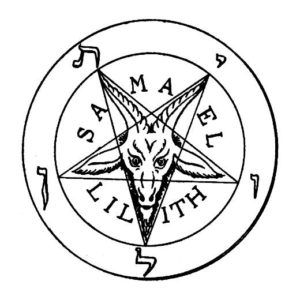

(Black) the trademarked logo of the Church of Satan,
(White) an illustration from La Clef de la Magie Noire by French occultist Stanislas de Guaita, from 1897, upon which this logo is based
The Hebrew inscribed in both circles reads “L,V,TH,I,N” or “Leviathan”; sometimes there are variants on this logo that use other Hebrew letters, often spelling out nothing at all; The words SAMAEL and LILITH refer to entities in the Zohar, a medieval text of Jewish mysticism.
Satan is, in at least one way of understanding, a concept so simple and insidious that if it did not exist, it would have to be invented anyways. Satan is a product of the adversarial algorithm, a notion discovered by one of our ancestors — the first person who committed or at least witnessed the first murder, somewhere some time many thousands of years ago on the Savannah, deep in our collective history.
But that’s Satan the figure, not Satanism, which entails that we look at social organisms.
There are several clusters of Satanism I have identified. There are two main “horns”, if you will: Atheistic and Theistic.
Atheistic Satanism consists of the humanist and atheist groups, some of whom have political agendas that span the left (such as The Satanic Temple) and right (Church of Satan being largely right-wing libertarian). For his time, LaVey was fairly progressive. He acknowledged gays, lesbians and bisexuals and even trans* aspects of sexual politics long before the mainstream public did. He also preserved a veneer of magical theatre in his writing, which was otherwise secular. The Temple of Set, which splintered off from CoS, has a more theistic approach and has focused on ceremonial magic rather than self-empowerment.
Of anecdotal interest, the CoS sells membership cards that one may send away for. They used to cost only a pittance, but people in third world countries began sending away for them in order to go to villages and threaten people with curses lest a fee be paid. The CoS raised their fees when they caught wind of this scam. Another group, The Satanic Temple, has been fairly prominent in opposing (and counter-protesting) attempts at putting the Ten Commandments on public display, in court houses and so on. Despite being atheistic, this group’s actions preserve the role of Satan as adversary.
The problem with being an atheistic satanist is that christians — who by and large hold all of the power all over the world — still will think you secretly worship the devil anyways. Why engage with something at the aesthetic level when you can go all the way?
Theistic Satanism is a constellation of movements, most of which are very small but nearly all of proceed from the notion of Satan as one actual, existent god amongst many other gods. It would properly be understood as a form of polytheism rather than monotheism. It is not merely “Reverse Christianity”* (something that few really practice outside of those who have a blasphemy fetish). Regardless of the type of theistic Satanism being explored, a primary departure from Christianity is that there is no savior god of any kind whatsoever to save your immortal soul (if such a soul even exists); one life and that’s it.
*A side note on “Reverse Christianity” that I found interesting: in Scandinavian countries, the churches are all state churches. So being a satanist in these countries also has a political component. It is lost in translation, but many Scandinavian people call others “reverse christians” to denote that they are basically “punks” or “anarchists” rather than the ordinary connotation of being a “poseur” who is just reversing the central tenets of Christianity.
Theistic Satanism should interest the Chaos Magickian as it is where a massive amount of innovation takes place. Or, rather, it is a frontier where a massive amount of innovation remains to take place. And to make it all better, the popularity of Satanism amongst the disaffected and disenfranchised (the most rapidly growing demographic in the world) provides a waiting audience. The other aspect is that few would be magickians were their lives (and the world) not in need of improvement. The infernal currents, of which there are not just one, provide a cathartic outlet in a world that increasingly has less and less truly free avenues of expression available.
One interesting sub-species of Theistic Satanism, Primitivist Satanism, probably has a handful of real practitioners. It rejects not only of the gods of society, their rules and morality, but the notion of society itself. The primitivist Satanist is a myth that keeps people afraid — a madman who just breaks all the laws and drinks blood and just doesn’t give a fuck. Society has spent a great deal of time constructing religions, but it has always spent just as much, as if not more, attention and money on building prisons and devising ways to punish. More on this in the lecture on Hell.
The notion of “Traditional Satanism,” also called “Devil Worship” is a modern, reconstructivist movement. As the name implies, it attempts to recreate what Satanism hypothetically would be if it were a religious tradition in its own right, with a freestanding written (or even oral) history of its own.
There are theistic satanist groups that claim to have tapped into a historically cohesive, unbroken lineages that span ancient times to the modern day, but these claims seem specious. The fact of the matter is that most Satanists hate each other at least as much as they hate the whole of society, and this in no small way has contributed to how small individual groups are. The expected lifespan of a Satanic group or order is countable in the days, not weeks or even years.
Theistic Satanism and Pagan Satanism — some neo-pagans embrace Satan as a part of their pantheon. I find that very few Satanists aside from the mentally ill ones, practice any form of satanic monotheism. It is something of a cliche that the first thing a neo-pagan will say to those outside their inner circle when pressed to describe their practices is, “it isn’t devil worship.” To me, this just plays into stereotypes and internalizes persecution.
Another interesting and more recent development in modern-day Satanism is the concept of the Left-Hand Path. The term enters the parlance of the modern magickian by way of a 1909 short story by Aleister Crowley, in which he describes a woman who apparently tried to cast a spell on him and kill him. Here, the use of the term LHP is for destructive (black) magic in stark contradistinction to magick that elevates oneself vertically. Curiously, the latter depiction of magick is in itself indicative of the notion of self-empowerment that LHP groups actually espouse. Others will typify LHP as “the descent into darkness”, or the pursuit of heterodoxy. There is also the claim that the RHP/LHP distinction goes back much further — “Vamachara” or heterodoxy being a concept in Hinduism. But this does not encapsulate the LHP as a *magickal* concept, only a religious concept, and adds a false stop to the history of religious disagreement. The first religion was a blasphemy against the vacuum from which it emerged, and forever onwards there has been heterodoxy as long as there has been orthodoxy to argue against. Then, less obvious, but impossible to ignore, is the observation that in Middle-eastern countries, the left hand is the one which wipes with. So the term has a scatological connotation to it, which I feel many self-professed LHP practitioners may neither intend nor agree with.
That said, I feel that the most generous and non-controversial way to differentiate the chirality of theology is:
RHP: “Oh, god! I adore thee!”, vs LHP: “I am a god, and I adore me!”
Decadent/nihilist Satanist — people who just do whatever they want, either taking Satan to be their token god, or a symbol of their indulgence (depending on whether they are theist or atheist).
And those just wanting to be offensive — Fascist/Neo-nazi Satanism. Fascist satanists fall into two camps: the first are the mentally ill, whose opinions don’t even matter. Here I include groups such as Joy of Satan, but there are individuals who are into this as well. They typically believe things such as Satan being a saviour god, usually from India or another, non-semitic area, and that the Jews are reptile aliens who control the world (this is what Joy of Satan actually claims). The Joy of Satan is unique in that it is an actual evangelical satanic group, and pester both Christians and Satanists alike with proselytizing similar to that of Jehova’s Witnesses and the Church of Latter Day Saints.
The other camp consists of what could roughly be called “sinister satanism.” There are both the individuals who have a sort of “I’m doing this to be offensive” outlook on things, as well as more organized groups such as the Order of Nine Angles and its affiliated splinter-groups. They have more in common with outlaw motorcycle clubs than with neo-nazis, but there is an aesthetic overlap. They view their platform as working towards the progress of the human species by culling (metaphorically or literally) weakness at the individual and societal level, but some of their members also view themselves as provocateurs who need only to react, not progress, in order to accomplish their work. The criticism of these groups is that they are fronts that indoctrinate people; on the other hand the supposed rituals that involve “culling” would, coupled with an affiliation with white power movements, would give the press a field day if anyone actually did it. In the end it may well be that the O9A only exists in the imagination of some people rather than in practice anywhere out there. The evidence for either just doesn’t exist.
On the subject of being offensive, there are also people with blasphemy fetishes, but looking back at Church history, it seems that blasphemy is an activity that many people engage in, not just those who oppose the church, but those who wish to innovate it. Blasphemy can be pro-Church, anyways: one could say that John the Baptist was the true messiah, not Jesus. This is pro-Church; one can say Jesus was a homosexual and fucked the 12 apostles; this is anti-Church.
And lastly, my favorite:
“Shut-ism” — taken from the title of the Kubric film, Eyes Wide Shut, which, like Naive Satanism, is not actually practiced by anyone at all, but the mentally ill and people in third world countries seem to think so anyways.
When trying to unfuck how these groups (including and/or especially Christian/Muslim groups that tell their members that real actual living Satanists who do bad things are out to get them) reconcile their theology with the historicity of Satan, I recommend a constructionist approach.
Constructionism is a epistemological stance that examines how jointly constructed understandings of the world develop and in turn form the substrate upon which these shared assumptions about reality then operate. It is only in this light that “Satanism” makes sense, as literally no organization that is called “Satanic” fully coheres to a historically accurate narrative. Some organizations gladly admit that they don’t — the Church of Satan uses the figure as an inspiration ripped free from historicity. Yet, other organizations make the bold and fully stupid claim that they have access to and understanding of the singular, real historical narrative. In almost all cases, these groups have political agendas and in modern times these are basically fringe national socialist groups such as Joy of Satan (which claims that Satan is a Babylonian god and that the world is governed by reptile aliens who Satan stands against).
Of course, there are small exceptions to the idea that there are no traditions or anything resembling consensus within Satanism. The next lecture will explore the Goetic tradition.
